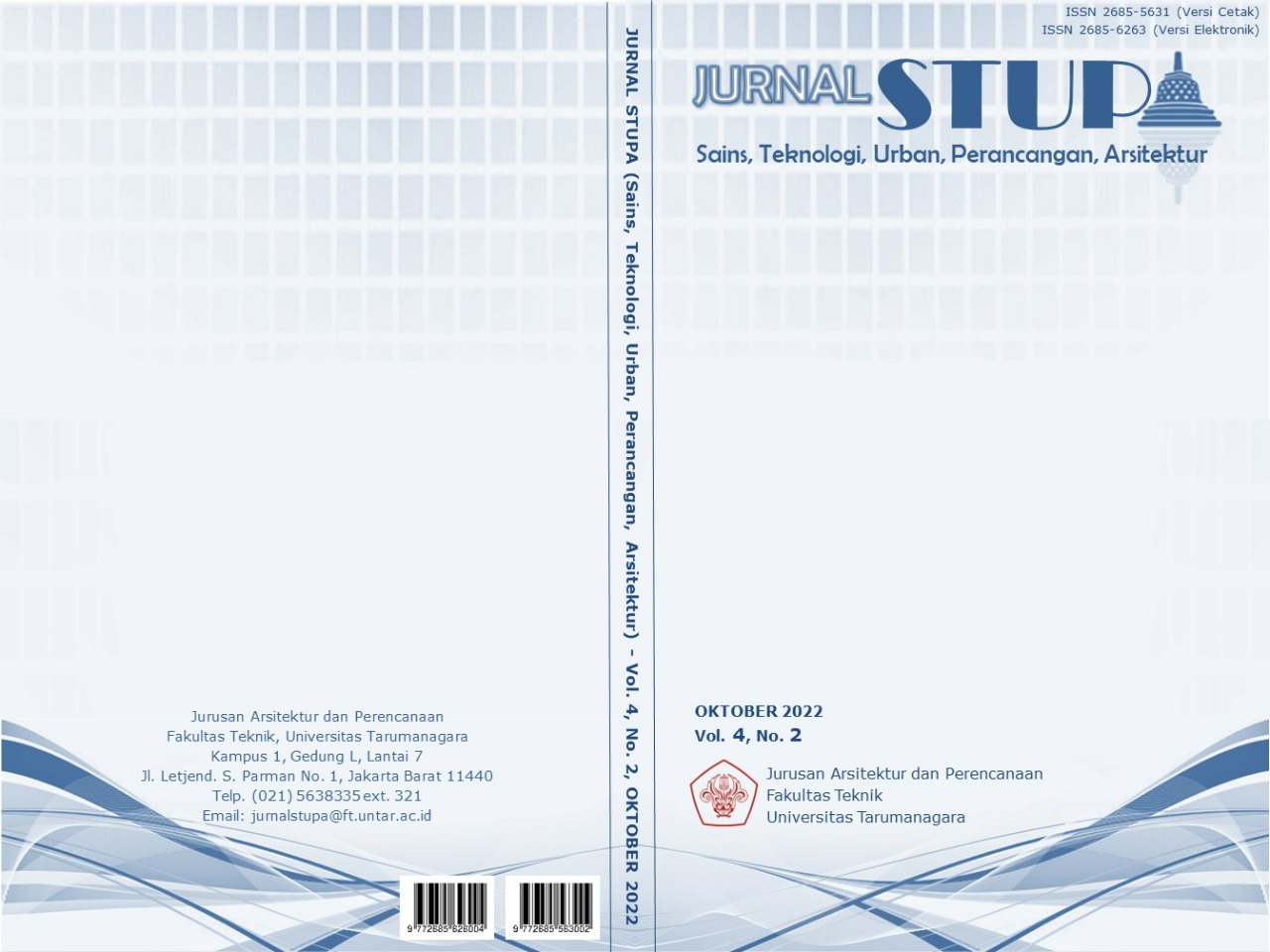METAVERSE DAN TEKNOLOGI DALAM DESAIN PASARAYA MANGGARAI
Main Article Content
Abstract
Pasaraya Manggarai is a shopping center which is a branch of Pasaraya Grande. Pasaraya was originally a shopping center building with the first department store system in Jakarta and is one of the buildings that has become the center of attention in the Manggarai area. But with current technological advances, Pasaraya, which used to look modern, is now considered old-fashioned and no longer attractive to young people, especially compared to other big malls in Jakarta. In addition, Pasaraya also did not provide many other facilities besides the shopping center itself, so the building had some difficulty attracting the public and eventually closed. Therefore, this project aims to make this shopping center more attractive by redesigning the building. This can be in the form of entertainment, dinner, and others. By looking at the technology developments of our current era, the planned design would implement various technologies to attract visitors’ attention merged with the Trans-programming method. This ensures the building is resistant and can adapt to changing times. The technology applied would mainly be Virtual Reality, Augmented Reality, and Mixed Reality Technology with the metaverse Concept. This technology is expected to provide a building atmosphere that has never existed before and make visitors feel like they are in another world.
Keywords: Architecture; Metaverse; Pasaraya; Shopping; Technology
Abstrak
Pasaraya Manggarai adalah sebuah pusat perbelanjaan yang merupakan cabang dari Pasaraya Grande. Pasaraya pada awalnya merupakan salah satu bangunan pusat perbelanjaan dengan sistem departement store pertama di Jakarta, dan merupakan salah satu bangunan yang menjadi pusat perhatian di area Manggarai. Tetapi dengan kemajuan teknologi saat ini, Pasaraya yang dahulu terlihat modern, sekarang sudah dianggap kuno dan tidak lagi menarik bagi kaum muda, apa lagi jika dibandingkan dengan mall-mall besar lain di Jakarta. Selain itu Pasaraya juga tidak menyiapkan banyak fasilitas lain selain dari pusat perbelanjaan itu sendiri, sehingga bangunan mengalami kesulitan untuk menarik perhatian masyarakat, dan akhirnya tutup. Oleh karena itu, proyek ini bertujuan untuk membuat pusat perbelanjaan ini lebih menarik dengan mendesain kembali bangunan. Hal ini dapat berupa entertainment, diner, dan lain lain. Dengan melihat perkembangan jaman kita saat ini juga, desain yang direncanakan akan mengimplementasikan berbagai macam teknologi untuk menarik perhatian pengunjung yang akan disatukan dengan metode Trans-programming. Hal ini dilakukan untuk memastikan bangunan tahan dan dapat beradaptasi dengan perubahan jaman. Teknologi yang diterapkan secara utama akan berupa teknologi Virtual Reality, Augemnted Reality, dan Mixed Reality dengan konsep metaverse. Penerapan teknologi ini diharapkan dapat memberikan suasana bangunan yang belum pernah ada sebelumnya, dan membuat pengunjung seperti berada pada dunia lain.
Article Details

This work is licensed under a Creative Commons Attribution-NonCommercial-ShareAlike 4.0 International License.
This work is licensed under a Jurnal Sains, Teknologi, Urban, Perancangan, Arsitektur/ STUPA Creative Commons Attribution-NonCommercial-ShareAlike 4.0 International LicenseReferences
Berman, B. (2019). Flatlined: Combatting the death of retail. Business Horizons, 62(1), 75-82. doi:10.1016/j.bushor.2018.08.006
Creswell, J. W., & Creswell, J. D. (2018). Research Design: Qualitative, Quantitative, and Mixed Methods Approaches (5 ed.). London, United Kindgom: SAGE Publications. Diambil kembali dari https://books.google.co.id/books/about/Research_Design.html?id=s4ViswEACAAJ&redir_esc=y
Han, Y., & Lee, H. (2020, 11 8). Augmented Reality Signage in Mixed-Use Shopping Mall Focusing on Visual Types of Directional Signage. International Conference on Human-Computer Interaction, 1294, 150-155. doi:10.1007/978-3-030-60703-6_19
Hoogduyn, R. (2014). Urban Acupuncture: Revitalizing urban areas by small scale interventions. Blekinge Institute of Technology, Department of Spatial Planning. Blekinge: Department of Spatial Planning. Diambil kembali dari https://www.diva-portal.org/smash/record.jsf?pid=diva2%3A832526&dswid=3960
Koch, J., Formmeyer, B., & Schewe, G. (2020, Desember 8). Online Shopping Motives during the COVID-19 Pandemic—Lessons from the Crisis. Sustainability, 12(24), 1-20. doi:10.3390/su122410247
Lee, J., & Lee, Y. (2019, Maret 28). Does online shopping make consumers feel better? Exploring online retail therapy effects on consumers’ attitudes towards online shopping malls. Asia Pacific Journal of Marketing and Logistics, 31(2), 464-479. doi:10.1108/APJML-06-2018-0210
Lee, L.-H., Braud, T., Zhou, P., Wang, L., Xu, D., Lin, Z., . . . Hui, P. (2021, September). All One Needs to Know about Metaverse: A Complete Survey on Technological Singularity, Virtual Ecosystem, and Research Agenda. Journal of Latex Class Files, 14(8), 1-66. doi:10.48550/ARXIV.2110.05352
Lee, R. J., Sener, I. N., Mokhtarian, P. L., & Handy, S. L. (2017, Juni). Relationships between the online and in-store shopping. Transportation Research Part A: Policy and Practice, 100, 40-52. doi:10.1016/j.tra.2017.03.001
Lerner, J. (2014). Urban Acupuncture. Washington: Island Press. Diambil kembali dari https://www.scribd.com/book/259397014/Urban-Acupuncture
McIntosh, R. W. (1977). Tourism: Principles, Practices, Philosophies. Grid. Diambil kembali dari https://books.google.co.id/books?id=HRVlpqpTasoC&hl=id&source=gbs_book_other_versions
Milgram, P., Takemura, H., Utsumi, A., & Kishino, F. (1994, Desember 21). Augmented reality: A class of displays on the reality-virtuality continuum. Photonics for Industrial Applications, Telemanipulator and Telepresence Technologies. 2351, hal. 282. Boston, MA, United States: Society of Photo-Optical Instrumentation Engineers (SPIE). doi:10.1117/12.197321
Murphy, P. E. (1986). Tourism: A Community Approach. Routledge. Diambil kembali dari https://www.amazon.com/Tourism-Community-Approach-Peter-Murphy/dp/0415045061
Mystakidis, S. (2022, Febuari 10). Metaverse. Encyclopedia, 2(1), 486-497. Diambil kembali dari https://www.mdpi.com/2673-8392/2/1/31
Renner, P., Lier, F., Friese, F., Pfeiffer, T., & Wachsmuth, S. (2018, Maret 1). Facilitating HRI by Mixed Reality Techniques. HRI: ACM/IEEE International Conference on Human-Robot Interaction (hal. 215–216). Chicago, IL, USA: Digital Library logoFull Citation in the ACM Digital Library. doi:10.1145/3173386.3177032
Tschumi , B. (1997). Architecture and Disjunction. Massachusetts: The MIT Press; Third printing. Diambil kembali dari https://www.scribd.com/document/393508734/286549922-Bernard-Tschumi-Architecture-and-Disjunction-pdf
Van Kerrebroeck, H., Brengman, M., & Willems, K. (2017, Desember). Escaping the crowd: An experimental study on the impact of a Virtual Reality. Computers in Human Behavior, 77(C), 437–450. doi:10.1016/j.chb.2017.07.019



